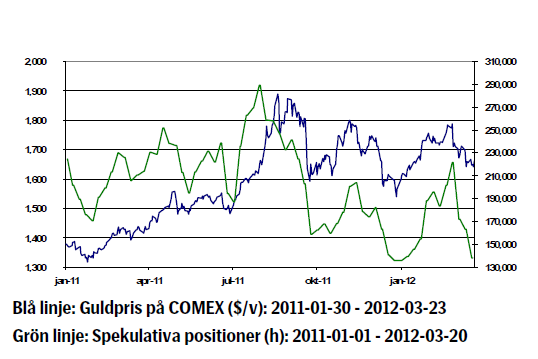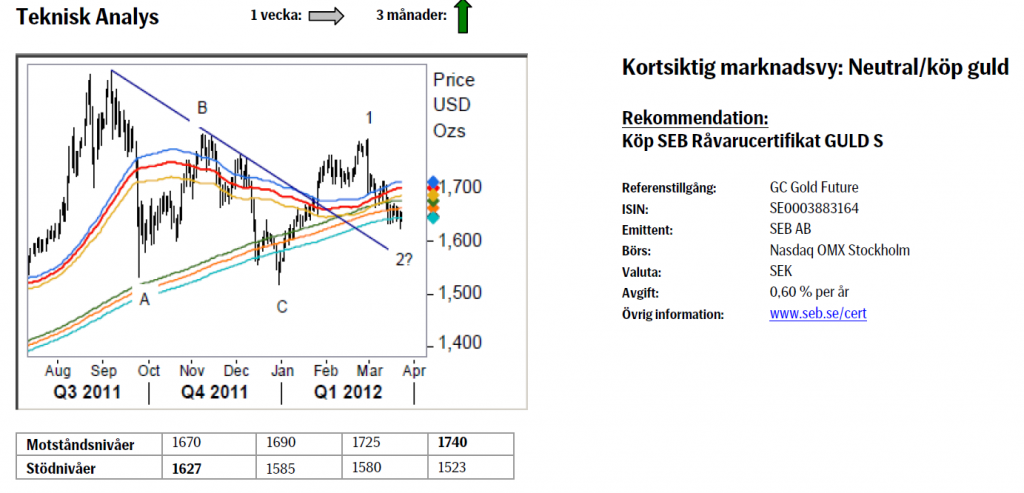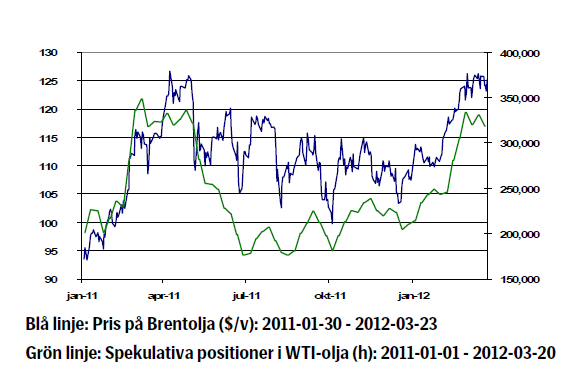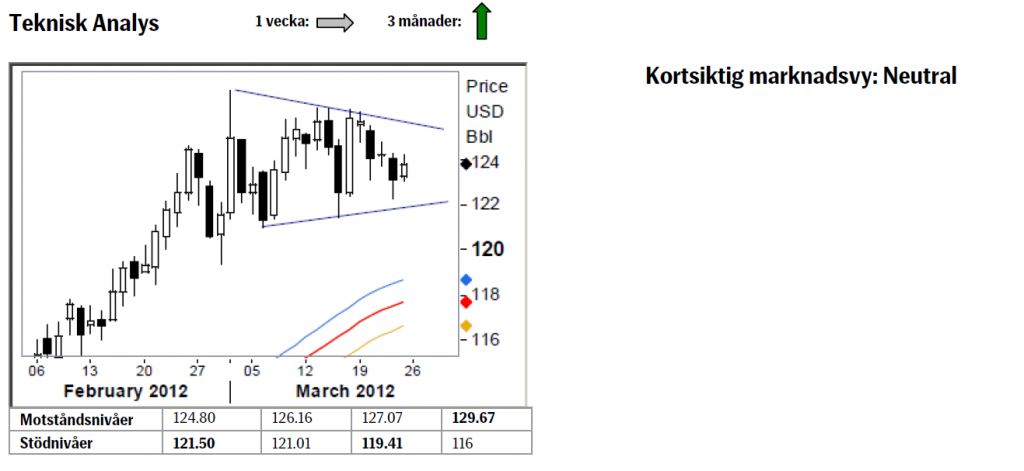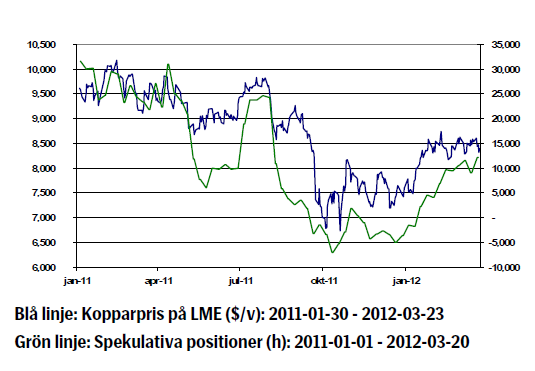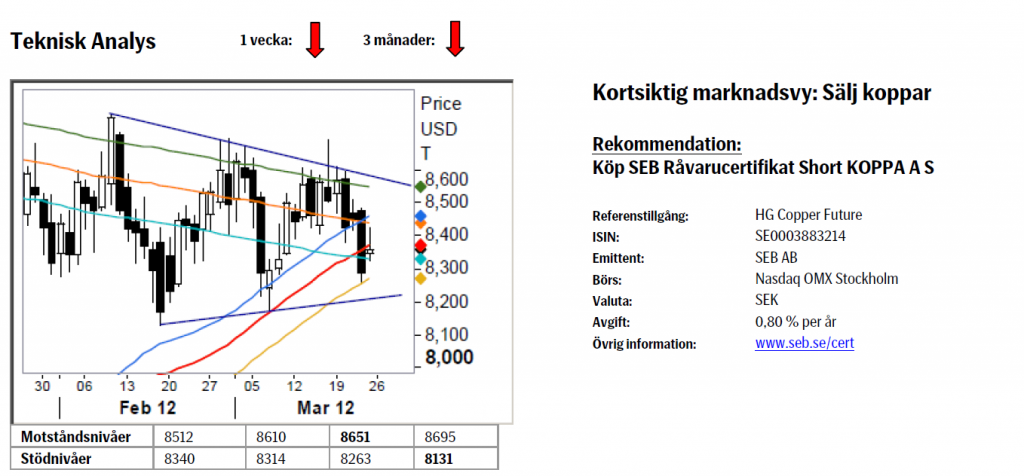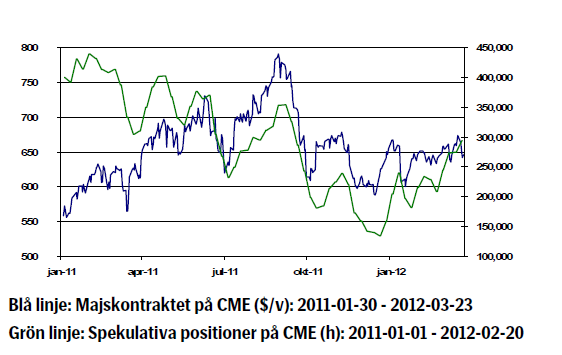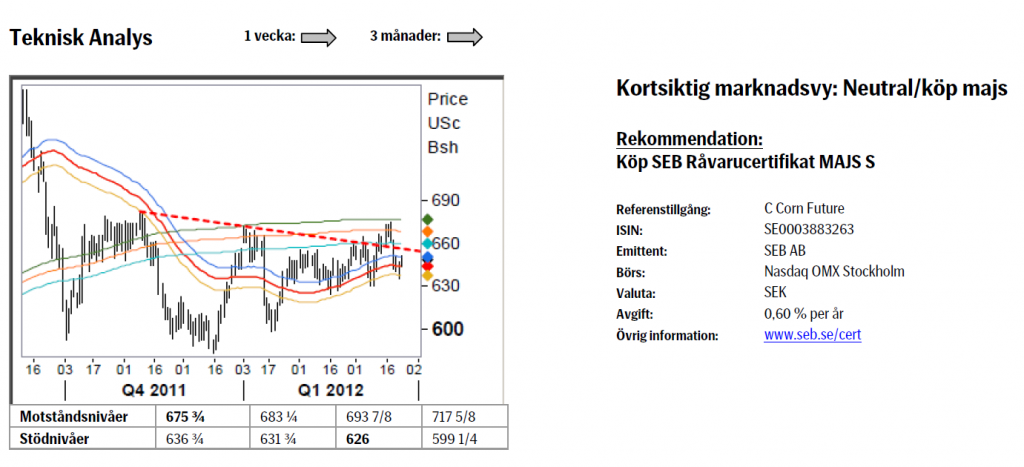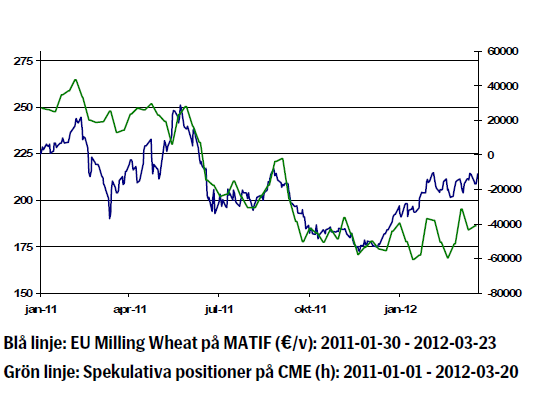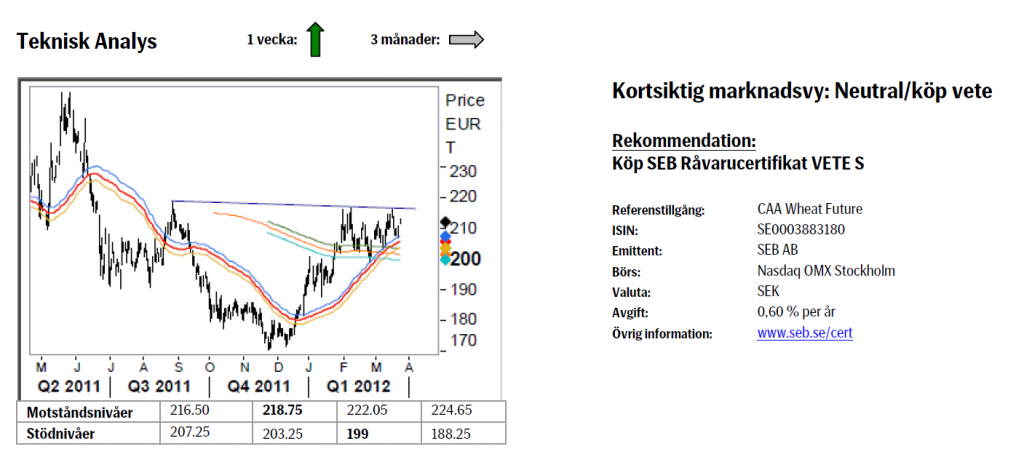Analys
SEB – Råvarukommentarer vecka 13 2012
Sammanfattning: Föregående vecka
- Brett råvaruindex: -1,33 %
UBS Bloomberg CMCI TR Index - Energi: -0,91 %
UBS Bloomberg CMCI Energy TR Index - Ädelmetaller: +0,11 %
UBS Bloomberg CMCI Precious Metals TR Index - Industrimetaller: -2,67 %
UBS Bloomberg CMCI Industrial Metals TR Index - Jordbruk: -0,92 %
UBS Bloomberg CMCI Agriculture TR Index
Kortsiktig marknadsvy:
- Guld: Neutral/köp
- Olja: Neutral
- Koppar: Sälj
- Majs: Neutral/köp
- Vete: Neutral/köp
Guld
- Det grekiska parlamentet godkände på onsdagen formellt det sparpaket som var förutsättningen för ett andra räddningspaket från EU och IMF. Detta var mest en formalitet men beskedet gav stöd åt euron. Denna föll emellertid igen på torsdagen då inköpsprisindex från Tyskland var sämre än förväntat. Dollarn steg och råvaror sjönk brett. Italiens premiärminister Monti varnade i helgen för att Spanien skulle kunna utlösa en ny allvarlig kris i EMU och uppmanade landet att ta kontroll över sin statsbudget. Oron för en recession i Europa ökar.
- Guldet föll totalt 6,5 procent förra veckan. Innehavare av fysiska ETF:er minskade sina innehav och världens största guld-ETF, SPDR Gold Trust, tappade 8 ton guld.
- Från den första april i år inför Indien en fyraprocentig importskatt på guld, en åtgärd som har lett till att landets 300 000 juvelerare nu strejkar. Indien är det land i världen som importerar störst mängd guld.
- Vi bedömer att guldpriset på kort sikt sannolikt inte kommer att kunna gå undernuvarande nivåer. Vid eventuella bakslag i den globala återhämtningen kan dock priset komma upp något igen. Med detta som bakgrund förhåller vi oss svagt positiva till guldpriset denna vecka.
- Teknisk Analys: Under den senaste veckan har marknaden i princip varje dag handlat ned under 233-dagarsbandet bara för att när dagen är slut ha återvänt in i det. Beteendet visar på kontinuerligt köpande i området och framför allt torsdagens kursrörelse indikerar att säljarna nu tappat kraft. Följaktligen fortsätter vi rekommendera försiktiga köp i området (över 1725/40 mer aggressivt då vi då kan bekräfta vändningen uppåt).
Olja
- Oljepriset föll totalt med 0,5 procent förra veckan, men i fredags steg Brentpriset plötsligt tre dollar efter en rapport från Petrologistics att oljeexporten från Iran väntas sjunka betydligt i mars. Råoljeexporten från Iran verkar falla med 300 000 fat olja per dag vilket motsvarar cirka tio procent av landets totala export.
- Bränslekostnader i Kina, vilka styrs direkt av kinesiska myndigheter, har höjts. Detta för att rädda landets raffinaderier vilka köper olja på rörligt pris men slutprodukter till fast pris. Detta medför i dagsläget ekonomiska problem för dem och bidrog till att oljepriset föll då man räknar med att efterfrågan minskar. Kina är världens näst största oljekonsument.
- Trots att det för tillfället inte råder någon brist på olja i marknaden så fortsätter oron kring Iran att ge stöd åt priset och rykten och nyheter gör att priset snabbt kan stiga. En hög riskpremie finns med andra ord kvar i marknaden. Både Bernanke och Obama har uttryckt oro för att oljepriset kommer att ligga kvar på nuvarande höga nivåer. Även i Europa uttrycks oro från politikers håll och Frankrike har annonserat att man överväger att släppa lös strategiska oljereserver. USA utövar påtryckningar på Kina och Indien att de ska minska oljeimporten från Iran, för att på så sätt undgå sanktioner från USA. De minskningar som länderna gjort hittills är inte tillräckliga.
- Teknisk Analys: Vår vy är sedan förra veckan helt oförändrad och kommer att så förbli tills antingen vi bryter upp ur triangeln bekräftandes vår vy om en ny topp i 129-131-området alternativt bryter ned under 121,50, vilket skulle göra triangeln obsolet och då snarare peka på en toppformation (såsom det ju eventuellt ser ut att bli i fallet koppar).Teknisk Analys: I och med brottet över aprilkontraktets tidigare topp förstärks uppåt potentialen. Nästa givna mål ska sökas vid 129.75/131.39 området, nästa Fibonacci projektionsområde. Där ovanför återfinns också toppen från 2007, 147.50. Det är dock noterbart att i €uro termer så handlas Brentoljan nu på nya rekordnivåer.
Koppar
- Kopparpriset föll 2,18 procent förra veckan. Det största raset skedde på torsdagen då priset föll till 8262 dollar per ton, det lägsta priset på två år. Inköpsprisindex från Europa och Kina kom in på lägre nivåer än förväntat vilket ökad farhågan i marknaden att efterfrågan på koppar, främst från Kina, kommer att minska.
- Kinesiskt HSBC:s flash-PMI för mars kom in svagare än föregående månad och föll från 49.6 till 48.1, vilket innebär att index nu legat under 50-nivån fem månader i rad. Index för nya ordrar föll och sysselsättningen noterade den lägsta nivån sedan mars 2009. Ett värde under 50 innebär en kontraktion.
- Kinesisk fastighetsmarknad har kylts av något, vilket också varit avsikten med myndigheternas restriktivare penningpolitik. Ytterligare ekonomiska stimulanser är inte troliga för tillfället från kinesiska myndigheters håll, vilket verkar dämpande på kopparpriset.
- Teknisk Analys: Det eventuellt positiva triangelscenario vi skrev om förra veckan har sedan dess tappat mark givet den kraftiga (dock fortsatt inom triangeln) nedgång som skett. Sannolikheten för ett negativt utfall måste därför anses ha ökat och ett test av stödområdet dvs. feb/mar-bottnarna bör ske under nästkommande vecka.
Majs
- Förra veckan började med ett par procents nedgång, detta efter svaga exportsiffror från USA och generella uttag från investerarkollektivet. Enligt CME fanns även viss oro för att det kinesiska majspriset skulle falla tillbaka något från förra veckans rekordnivåer.
- Torsdagens svaga inköpchefsindexsiffror från Europa och Kina satte nedåttryck på råvarupriserna, detta med undantag för jordbrukssektorn. Signaler om en god global efterfrågan och frågetecken kring den kommande majsskörden i Nord- och Sydamerika tryckte exempelvis majspriset uppåt. Med andra ord var tendenserna de omvända jämfört med den första halvan av veckan.
- Vidare gick en statlig kinesisk nyhetskanal i torsdags ut med indikationer om ett växande underskott av majs de kommande åren. Även om denna typ av utspel inte påverkar priset direkt ökar den generella efterfrågan och kan på så sätt ge kortsiktigt stöd åt priset.
- Denna vecka håller vi ögonen på Argentina, där både majs och sojabönor har fått visst stöd uppåt av landets försämrade produktionsutsikter. Vi bibehåller med detta vår kortsiktigt svagt positiva syn.
- Teknisk Analys: Uppenbarligen ropade vi hej lite för tidigt förra veckan. Brottet över trendlinjen fick aldrig sin givna fortsättning, ett brott av 233-dagarsbandet och följaktligen tröttnande snart köparna och stängde en lång position. Så vi är nu tillbaka på ruta ett i det neutrala området mellan medelvärdesbanden.
Vete
- Precis som majs och sojabönor gick vetet svagt under första halvan av veckan, där framförallt investerare valde att minska andelen jordbruksråvaror i portföljerna. De gynnsamma regn som föll i de vintervetesproducerande delarna av USA förstärkte denna rörelse ytterligare.
- Även om vetepriset i Chicago återhämtade sig något under torsdagen och fredagen var det ingenting mot den rörelse vi kunde se i Paris, där priset under denna period steg med drygt 2,5 procent och innebar en knapp uppgång jämfört med veckan innan.
- Enligt analysfirman DTN väntas den kommande veckan bli ovanligt torr i stora delar av Europa, vilket kan påverka den nuvarande skörden av vintervete. Denna oro får anses vara central för den starka avslutningen förra veckan.
- Under februari månad spekulerades det en hel del kring huruvida den ryska skörden av vintervete skulle bli väsentligen sämre än vad marknaden tidigare hade förväntat sig. Det extremt kalla vädret gjorde att risken för omfattande produktionsbortfall (som en konsekvens av frostskador) ansågs vara stor. Enligt Bloomberg har nu ryska spannmålsorgan kunnat bekräfta att bortfallet inte är så stort som man befarat.
- Med den förväntade torkan i Europa som starkaste argument förhåller vi oss fortsatt svagt positiva till vetepriset på MATIF.
- Teknisk Analys: Konsolideringen ovanför medelvärdesbanden har fortsatt även den senaste veckan. Vår förväntan är att vi kommer att bryta upp över topplinjen vilken vecka som helst och att ett sådant brott i sinom tur bör kunna utlösa en rörelse upp emot majtoppen från förra året. Bara ett överraskande brott under 199 förändrar ovanstående vy.
[box]SEB Veckobrev Veckans råvarukommentar är producerat av SEB Merchant Banking och publiceras i samarbete och med tillstånd på Råvarumarknaden.se[/box]
Disclaimer
The information in this document has been compiled by SEB Merchant Banking, a division within Skandinaviska Enskilda Banken AB (publ) (“SEB”).
Opinions contained in this report represent the bank’s present opinion only and are subject to change without notice. All information contained in this report has been compiled in good faith from sources believed to be reliable. However, no representation or warranty, expressed or implied, is made with respect to the completeness or accuracy of its contents and the information is not to be relied upon as authoritative. Anyone considering taking actions based upon the content of this document is urged to base his or her investment decisions upon such investigations as he or she deems necessary. This document is being provided as information only, and no specific actions are being solicited as a result of it; to the extent permitted by law, no liability whatsoever is accepted for any direct or consequential loss arising from use of this document or its contents.
About SEB
SEB is a public company incorporated in Stockholm, Sweden, with limited liability. It is a participant at major Nordic and other European Regulated Markets and Multilateral Trading Facilities (as well as some non-European equivalent markets) for trading in financial instruments, such as markets operated by NASDAQ OMX, NYSE Euronext, London Stock Exchange, Deutsche Börse, Swiss Exchanges, Turquoise and Chi-X. SEB is authorized and regulated by Finansinspektionen in Sweden; it is authorized and subject to limited regulation by the Financial Services Authority for the conduct of designated investment business in the UK, and is subject to the provisions of relevant regulators in all other jurisdictions where SEB conducts operations. SEB Merchant Banking. All rights reserved.
Analys
Tightening fundamentals – bullish inventories from DOE

The latest weekly report from the US DOE showed a substantial drawdown across key petroleum categories, adding more upside potential to the fundamental picture.

Commercial crude inventories (excl. SPR) fell by 5.8 million barrels, bringing total inventories down to 415.1 million barrels. Now sitting 11% below the five-year seasonal norm and placed in the lowest 2015-2022 range (see picture below).
Product inventories also tightened further last week. Gasoline inventories declined by 2.1 million barrels, with reductions seen in both finished gasoline and blending components. Current gasoline levels are about 3% below the five-year average for this time of year.
Among products, the most notable move came in diesel, where inventories dropped by almost 4.1 million barrels, deepening the deficit to around 20% below seasonal norms – continuing to underscore the persistent supply tightness in diesel markets.
The only area of inventory growth was in propane/propylene, which posted a significant 5.1-million-barrel build and now stands 9% above the five-year average.
Total commercial petroleum inventories (crude plus refined products) declined by 4.2 million barrels on the week, reinforcing the overall tightening of US crude and products.


Analys
Bombs to ”ceasefire” in hours – Brent below $70

A classic case of “buy the rumor, sell the news” played out in oil markets, as Brent crude has dropped sharply – down nearly USD 10 per barrel since yesterday evening – following Iran’s retaliatory strike on a U.S. air base in Qatar. The immediate reaction was: “That was it?” The strike followed a carefully calibrated, non-escalatory playbook, avoiding direct threats to energy infrastructure or disruption of shipping through the Strait of Hormuz – thus calming worst-case fears.

After Monday morning’s sharp spike to USD 81.4 per barrel, triggered by the U.S. bombing of Iranian nuclear facilities, oil prices drifted sideways in anticipation of a potential Iranian response. That response came with advance warning and caused limited physical damage. Early this morning, both the U.S. President and Iranian state media announced a ceasefire, effectively placing a lid on the immediate conflict risk – at least for now.
As a result, Brent crude has now fallen by a total of USD 12 from Monday’s peak, currently trading around USD 69 per barrel.
Looking beyond geopolitics, the market will now shift its focus to the upcoming OPEC+ meeting in early July. Saudi Arabia’s decision to increase output earlier this year – despite falling prices – has drawn renewed attention considering recent developments. Some suggest this was a response to U.S. pressure to offset potential Iranian supply losses.
However, consensus is that the move was driven more by internal OPEC+ dynamics. After years of curbing production to support prices, Riyadh had grown frustrated with quota-busting by several members (notably Kazakhstan). With Saudi Arabia cutting up to 2 million barrels per day – roughly 2% of global supply – returns were diminishing, and the risk of losing market share was rising. The production increase is widely seen as an effort to reassert leadership and restore discipline within the group.
That said, the FT recently stated that, the Saudis remain wary of past missteps. In 2018, Riyadh ramped up output at Trump’s request ahead of Iran sanctions, only to see prices collapse when the U.S. granted broad waivers – triggering oversupply. Officials have reportedly made it clear they don’t intend to repeat that mistake.
The recent visit by President Trump to Saudi Arabia, which included agreements on AI, defense, and nuclear cooperation, suggests a broader strategic alignment. This has fueled speculation about a quiet “pump-for-politics” deal behind recent production moves.
Looking ahead, oil prices have now retraced the entire rally sparked by the June 13 Israel–Iran escalation. This retreat provides more political and policy space for both the U.S. and Saudi Arabia. Specifically, it makes it easier for Riyadh to scale back its three recent production hikes of 411,000 barrels each, potentially returning to more moderate increases of 137,000 barrels for August and September.
In short: with no major loss of Iranian supply to the market, OPEC+ – led by Saudi Arabia – no longer needs to compensate for a disruption that hasn’t materialized, especially not to please the U.S. at the cost of its own market strategy. As the Saudis themselves have signaled, they are unlikely to repeat previous mistakes.
Conclusion: With Brent now in the high USD 60s, buying oil looks fundamentally justified. The geopolitical premium has deflated, but tensions between Israel and Iran remain unresolved – and the risk of missteps and renewed escalation still lingers. In fact, even this morning, reports have emerged of renewed missile fire despite the declared “truce.” The path forward may be calmer – but it is far from stable.
Analys
A muted price reaction. Market looks relaxed, but it is still on edge waiting for what Iran will do

Brent crossed the 80-line this morning but quickly fell back assigning limited probability for Iran choosing to close the Strait of Hormuz. Brent traded in a range of USD 70.56 – 79.04/b last week as the market fluctuated between ”Iran wants a deal” and ”US is about to attack Iran”. At the end of the week though, Donald Trump managed to convince markets (and probably also Iran) that he would make a decision within two weeks. I.e. no imminent attack. Previously when when he has talked about ”making a decision within two weeks” he has often ended up doing nothing in the end. The oil market relaxed as a result and the week ended at USD 77.01/b which is just USD 6/b above the year to date average of USD 71/b.

Brent jumped to USD 81.4/b this morning, the highest since mid-January, but then quickly fell back to a current price of USD 78.2/b which is only up 1.5% versus the close on Friday. As such the market is pricing a fairly low probability that Iran will actually close the Strait of Hormuz. Probably because it will hurt Iranian oil exports as well as the global oil market.
It was however all smoke and mirrors. Deception. The US attacked Iran on Saturday. The attack involved 125 warplanes, submarines and surface warships and 14 bunker buster bombs were dropped on Iranian nuclear sites including Fordow, Natanz and Isfahan. In response the Iranian Parliament voted in support of closing the Strait of Hormuz where some 17 mb of crude and products is transported to the global market every day plus significant volumes of LNG. This is however merely an advise to the Supreme leader Ayatollah Ali Khamenei and the Supreme National Security Council which sits with the final and actual decision.
No supply of oil is lost yet. It is about the risk of Iran closing the Strait of Hormuz or not. So far not a single drop of oil supply has been lost to the global market. The price at the moment is all about the assessed risk of loss of supply. Will Iran choose to choke of the Strait of Hormuz or not? That is the big question. It would be painful for US consumers, for Donald Trump’s voter base, for the global economy but also for Iran and its population which relies on oil exports and income from selling oil out of that Strait as well. As such it is not a no-brainer choice for Iran to close the Strait for oil exports. And looking at the il price this morning it is clear that the oil market doesn’t assign a very high probability of it happening. It is however probably well within the capability of Iran to close the Strait off with rockets, mines, air-drones and possibly sea-drones. Just look at how Ukraine has been able to control and damage the Russian Black Sea fleet.
What to do about the highly enriched uranium which has gone missing? While the US and Israel can celebrate their destruction of Iranian nuclear facilities they are also scratching their heads over what to do with the lost Iranian nuclear material. Iran had 408 kg of highly enriched uranium (IAEA). Almost weapons grade. Enough for some 10 nuclear warheads. It seems to have been transported out of Fordow before the attack this weekend.
The market is still on edge. USD 80-something/b seems sensible while we wait. The oil market reaction to this weekend’s events is very muted so far. The market is still on edge awaiting what Iran will do. Because Iran will do something. But what and when? An oil price of 80-something seems like a sensible level until something do happen.
-

 Nyheter4 veckor sedan
Nyheter4 veckor sedanStor uppsida i Lappland Guldprospekterings aktie enligt analys
-

 Nyheter4 veckor sedan
Nyheter4 veckor sedanSilverpriset släpar efter guldets utveckling, har mer uppsida
-

 Nyheter3 veckor sedan
Nyheter3 veckor sedanUppgången i oljepriset planade ut under helgen
-

 Nyheter3 veckor sedan
Nyheter3 veckor sedanLåga elpriser i sommar – men mellersta Sverige får en ökning
-

 Nyheter2 veckor sedan
Nyheter2 veckor sedanMahvie Minerals växlar spår – satsar fullt ut på guld
-

 Analys3 veckor sedan
Analys3 veckor sedanVery relaxed at USD 75/b. Risk barometer will likely fluctuate to higher levels with Brent into the 80ies or higher coming 2-3 weeks
-

 Nyheter1 vecka sedan
Nyheter1 vecka sedanOljan, guldet och marknadens oroande tystnad
-

 Nyheter1 vecka sedan
Nyheter1 vecka sedanJonas Lindvall är tillbaka med ett nytt oljebolag, Perthro, som ska börsnoteras



